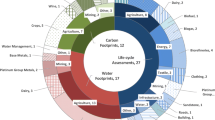Abstract
Establishing BAT (Best Available Techniques) for processes subject to IPPC is a new barrier and one that processes in the development stage need to be aware of. For multi-functional processes, the sectorial approach adopted under IPPC (Integrated Pollution Prevention and Control) increases the potential problems. Life Cycle Assessment (LCA) is an established tool to assist establishing BAT but is difficult to apply in its full form at the Research and Development (R&D) stage. A review of LCA in the context of a case study, the Trefoil kiln process, concludes that it has the flexibility to cope with multi-functionality and that use of key environmental issues and key indicators could overcome the informational gaps. Environmental burdens can be presented appropriately provided the research identifies appropriate allocation methods. The use of LCA thinking provided useful insight on the content of the research programme.
Similar content being viewed by others
References
ENDS (1997): Guidance for IPPC process gets under way. Report Series 268. Environmental Data Services Ltd., Bowling Green Lane, London
ENDS (1999): Draft IPPC regulations. Report Series 295. Environmental Data Services Ltd., Bowling Green Lane, London
Geldermann J, Jahn C, Spengler T, Rentz O. (1999): Proposal for an integrated approach for the assessment of cross-media aspects relevant for the determination of ‘Best Available Techniques’ BAT in the European Union. Int J LCA 4 (2) 94–106
Consoli F et al. (eds) (1993): Guidelines for life cycle assessment: A ‘Code of Practice’. SETAC, Brussels
CEN—European Committee for Standardization (EN ISO 14040: 1997), (EN ISO 14041: 1998), (prEN ISO/FDIS 14042: Jul 1999), (prEN ISO/DIS 14043: December 1998)
Udo De Haes HA, Wrisberg N (eds) (1997): LCANET: European network for strategic life cycle assessment research and development. LCA Documents Vol 1, Kloepffer W, Hutzinger O (eds) Eco-Informa Press, Bayreuth, Germany and ecomed publishers, Landsberg, Germany
Weitz K, Todd JA, Curran MA, Malkin MJ (1996): Streamlining life cycle assessment — Considerations and a report on the State of Practice. Int J LCA 1 (2) 79–85
Weitz K, Sharma A, Vigon B, Price E, Norris G, Eagan P, Oens W, Veroutis A (1999): Streamlined life cycle assessment: A Final Report from the SETAC North America Streamlined LCA Workgroup. Society of Environmental Toxicology and Chemistry, SETAC North America
SEATC Europe (eds), (May 1997): Streamlining LCA: Just a cut? — Final report of SETAC Europe. LCA Screening and Streamlining Working Group, Brussels
Wainright PJ, Barton JR (1998): Utilising innovative rotary kiln technology to recycle waste into synthetic aggregate. Proceedings of the 1998 EU Contractors’ Workshop on Heavy Metals Removal from Liquid Effluents, Waste Incineration and Generic Technologies for Recycling, TRAWMAR Vol 1, Greece
Wainwright PJ, Barton JR, Cresswell DJF (2000): The Long Term performance of untreated Bottom Ash, and the Production and use of a lightweight synthetic aggregate from the Bottom Ash fine fraction. In: Use of incinerator ash. Dhir RK, Dyer TD, Paine KA (eds) Thomas Telford Ltd, London
Parks LF, Sherwen RG (1986): The Use of New Materials in an Improved Design of Rotary Kiln. Materials & Design 7 (5) 252–255
Udo De Haes HA, Benshahal JF, Clift R, Fussier C, Griesshammer R, Jenson AA (1994): Guidelines for application of life cycle assessment in the EU ecolabelling programme. Final report of the first phase, Groupe des Sages, Commission of the European Union, Brussels
Barton JR et al. (1996): Life cycle assessment for waste management. Waste Management16 (1–3) 35–50, Elsevier Science Ltd, Great Britain
DETR (2000): Waste strategy 2000: England and Wales (Parti and 2). Department of the Environment, Transport and Regions, UK
Heyde M, Kremer M (1999): Recycling and recovery of plastics from packagings in domestic waste. LCA Documents Vol 5, Kloepffer W, Hutzinger O (eds) Eco-Informa Press, Bayreuth, Germany and ecomed publishers, Landsberg, Germany
White PR, Franke M, Hindle P (1995): Integrated solid waste management — A life cycle inventory. Blackie Academic & Professional
Heijungs R, Frischknecht R (1998): A special view on the nature of the allocation problem. Int J LCA 3 (5) 321–332
SETAC (1994): Proceedings of the European Workshop on Allocation in LCA. Leiden University, The Netherlands, 24–25 February 1994
Kremer M, Gldhan G, Heyde M (1998): Waste treatment in product specific life cycle inventories — Part I: Incineration. Int J LCA 3 (1) 47–55
Azapagic A, Clift R (1999): Allocation of environmental burdens in multiple-function systems. J Cleaner Prod 7 (2) 101–119
Ekvall T, Tillman AM (1997): Open-loop recycling: criteria for allocation procedures. Int J LCA 2 (3) 155–162
Kloepffer W (1996): Allocation rule for open-loop recycling in life cycle assessment — A Review. Int J LCA 1(1) 27–31
Seum S (1998): The HoVe assessment method: Principal structure and pilot application. Int J LCA 3 (4) 191–199
Tukker A (1999): Life cycle assessment for waste, Part I. Int J LCA 4 (5) 275–281
Wainwright P et al (2000): Utilising innovative rotary kiln technology to recycle waste into synthetic aggregate. First and second interim report (unpublished)
Sherwood PT (1995): Alternative materials in road construction. Thomas Telford Services Ltd, London
Smith SR (1996): Agricultural recycling of sewage sludge and the environment. CAB International Oxon, UK
OECD (1997): Up-dated environmental data compendium 1997. Organisation for Economic Co-operation and Development, Paris 1997
EEA (1999): European topic centre for waste. European Environment Agency, Copenhagen, Denmark.
Nicholas MJ, Clift R, Azapagic A, Walker FC, Porter DE (2000): Determination of ‘Best Available Techniques’ for integrated pollution prevention and control — A life cycle approach. Trans IChemE, Vol 78, Part B, May 2000
Author information
Authors and Affiliations
Corresponding author
Rights and permissions
About this article
Cite this article
Barton, J.R., Schneider, A. & Jager, J. Role of LCA in the design of research and development (R&D) of novel processes subject to IPPC and BAT. Int J LCA 7, 11–17 (2002). https://doi.org/10.1007/BF02978905
Received:
Accepted:
Issue Date:
DOI: https://doi.org/10.1007/BF02978905



